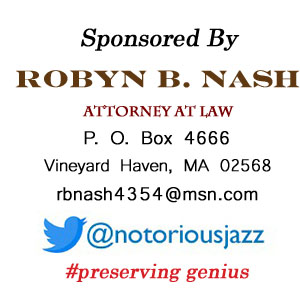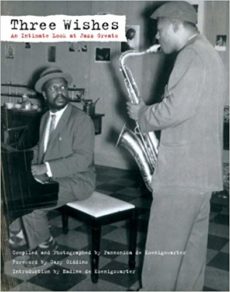
Three Wishes
The question of three wishes arose when Pannonica asked Sonny Nevius of his:
- “To have my wife and baby to be, like, happy. Very happy. As happy as could be.”
- “For my music career to be just like moving up ~ up tot he top, man! As far as I could go. But to be the same Sonny, man, all the time.”
- “Just to be able to live relaxed, like, contented, you know, with my family, in my own home and forget about the world. That’d be my three wishes..”
*Excerpt from Three Wishes: An Intimate Look at Jazz Greats ~ Compiled and Photographed by Pannonica de Koenigswarter
More Posts: baroness,history,instrumental,jazz,music,pannonica,three,vocal,wishes
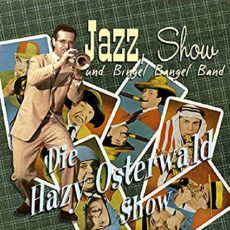
Daily Dose Of Jazz…
Hazy Osterwald was born Rolf Osterwald on February 18, 1922 in Bern, Switzerland. He began his career as a pianist, arranged for Fred Böhler in the late 1930s and joined him as a trumpeter in 1941. Around this time he also worked with Edmond Cohanier, Philippe Brun, Bob Huber, Eddie Brunner and Teddy Stauffer.
Hazy led his own ensemble starting in 1944, recording through the 1970s, with sidemen including Ernst Höllerhagen and Werner Dies. In the late 1940s he recorded with Gil Cuppini and played at the Paris Jazz Fair with Sidney Bechet and Charlie Parker. Trumpeter, vibraphonist, vocalist and bandleader Hazy Osterwald passed away on February 26, 2012 in Lucerne Switzerland.
More Posts: bandleader,history,instrumental,jazz,music,trumpet,vibraphone,vocal

Daily Dose Of Jazz…
Harry Dial was born on February 17, 1907 in Birmingham, Alabama who became one of the classic drummers of the early jazz world. His specialty was keeping time behind artists known for their fun and pep. In fact, a glance at Dial’s discography is something like a partial scan of the most entertaining albums of all time, because such a list would surely include sides by two guys named Louis, Armstrong and Jordan, as well as Fats Waller and Ella Fitzgerald.
Harry was a solid, energetic drummer who pushed the beat forward without cluttering the airspace. His use of the sock cymbal and his fat, marching band snare drum sound are often imitated. He was also one of the rare breeds of singing drummers, the vocal side of his talents usually only exposed when he was in charge of the band. He was allowed to make comments on records with Fats Waller, the best example of which is the introduction to the upbeat Don’t Let It Bother You.
Dial’s career as a bandleader included a series of sides for Vocalion beginning in 1930. The group, whose recordings included the deadly “Poison,” was known as Harry Dial’s Blusicians, and included players such as banjoist Eursten Woodfork, trumpeter Shirley Clay, and the fine alto saxophonist Lester Boone. Some of this material has been reissued on the compilation Chicago 1929-1930: That’s My Stuff.
He was already recording with Armstrong around this time and began cutting tracks with Waller as a member of Fats Waller’s Rhythm before the middle of that decade. It might have taken him an additional ten years to master the art of playing the maracas since he seemed to find a way to include the delicate shakers on just about every funny style of music he played with Jordan beginning in the mid-’40s when he joined the Tympany Five.
In the late ’40s, he took another crack at recording under his own name, producing “Prince’s Boogie” for Decca with one of the earliest versions of the catchy “Diddy Wah Diddy” on the flipside. Dial liked to write as well, beginning with a song entitled “Don’t Play Me Cheap,” recorded by the famous Armstrong. His songs were also recorded by the merely infamous, a category that would not exist if it didn’t include a singer named Bea Booze, who cut Dial’s “Catchin’ as Catch Can” for Decca in 1942.
Many years later, the drummer published his All This Jazz About Jazz: The Autobiography of Harry Dial. The dapper, suave musician would have felt it important that he is most certainly not the Harry Dial who made it into the Guinness Book of World Records by claiming to have gone 78 years without bathing. Drummer Harry Dial passed away on January 25, 1987 in New York City.
More Posts: author,bandleader,drums,history,instrumental,jazz,music
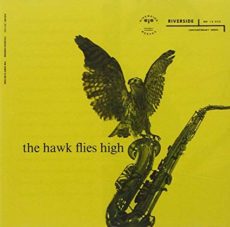
Requisites
The Hawk Flies High is an album by jazz tenor saxophonist Coleman Hawkins. Apart from Barry Galbraith and Jo Jones on guitar and drums, the line-up of his accompanying sextet had a bebop background. The year is 1957, the dates, March 12th, and 15th, and Reeves Sound Studios at 304 East 44th Street is the destination.
Track Listing | 39:02
- Chant (Hank Jones) – 5:08
- Juicy Fruit (Idrees Sulieman) – 11:16
- Think Deep (William O. Smith) -3:24
- Laura (David Raksin, Johnny Mercer) -4:34
- Blue Lights (Gigi Gryce) -5:44
- Sancticity (Hawkins) -9:10
- Coleman Hawkins – tenor saxophone
- Hank Jones – piano
- Oscar Pettiford – bass
- Jo Jones – drums
- Barry Galbraith – guitar
- J.J. Johnson – trombone
- Idrees Sulieman – trumpet
Coleman Hawkins ~ The Hawk Flies High | by Eddie Carter
Tenor saxophonist Coleman Hawkins steps into the spotlight with his only album as a leader for Riverside Records, The Hawk Flies High (Riverside Contemporary Series 12-233). Originally recorded and released in 1957, this album and the other five he would record for Prestige; Soul (PRLP 7149) and Blues Groove with Tiny Grimes (PRLP 7138/PRST 7753) in 1958; Very Saxy with Eddie “Lockjaw” Davis, Buddy Tate, Arnett Cobb (PRLP 7167); Hawk Eyes (PRLP 7156) and Coleman Hawkins with The Red Garland Trio (Prestige Swingville SVLP 2001) in 1959 became essential parts of his impressive discography. Also, reviving his career as one of the perennial jazz musicians in the world until his death from liver disease on May 19, 1969. My copy used in this report is the 2007 Mobile Fidelity Sound Lab Limited Edition, Half-Speed Mastered Mono Audiophile Reissue (MFSL 1-290). Producer Orrin Keepnews gave Bean (as he was also known) the freedom to choose the personnel he wanted, and he picked a dream lineup to share the date; Idrees Sulieman on trumpet; J.J. Johnson on trombone; Hank Jones on piano; Barry Galbraith on guitar; Oscar Pettiford on bass and Jo Jones on drums.
Side One opens with Hank Jones’ Chant; a midtempo original tailor-made for tuneful blowing by the septet on the melody and five sprightly solos by Hawk, Julie, J.J., Hank, and Oscar. Bean takes charge first, telling a great story with a captivating opening chorus. Sulieman’s trumpet is deliciously appetizing on the next reading, then Johnson fills the third solo with an ecstatic swing. Jones’ ideas flow with finesse on the next performance, and Pettiford swings with light agility on the closing statement before the coda. Idrees Sulieman’s Juicy Fruit is a blues that gradually rises from a march-like introduction to the mid-tempo melody. The trumpeter sustains a single note for nearly a minute (fifty-seconds to be exact) before settling into some bluesy smooth sailing on the lead solo. Coleman endows the next reading with long, flowing mellow lines that are enjoyable. J.J. conjures up some especially inventive playing that develops subtly over the easy, relaxing beat. Hank solos next cultivating an irresistible warmth over the gently rocking groundwork of the rhythm section. Oscar comes in behind him maintaining a relaxed attitude with poise and self-assurance before the ensemble takes the song out.
Think Deep by jazz clarinetist William Smith begins leisurely with Hawk leading the septet on the hauntingly beautiful melody and closing chorus. As the song’s only soloist, the venerable tenor man turns in a very satisfying intimate performance reminiscent of the spontaneously perfect solo he performed on Body and Soul for Bluebird Records (10523) in 1939. Side Two starts with Laura by David Raskin who composed it for the 1944 film of the same name. This classic jazz standard is featured throughout the film noir drama and has been recorded over four-hundred times. Lyricist Johnny Mercer created the words for Laura in 1945 after the film became a huge hit, later admitting he never saw the film before writing them. Raskin also founded a little-known label called Capitol Records and has written over fifteen-hundred lyrics. Sulieman lays out of this version, therefore showcasing Coleman and J.J. who clearly make two convincing cases for interpreting a ballad. The graceful mood is established by the rhythm section for the song’s introduction. Bean states the theme with passionate tenderness, then impresses on an expressively gentle first solo. J.J. adds notes of dreamlike beauty that’s beautifully captured on the closing chorus leading to a subtle climax by Hawk.
Blue Lights by multi-instrumentalist Gigi Gryce made its debut on the 1957 album When Farmer Met Gryce (Prestige PRLP 7085) while he was a member of The Art Farmer Quintet. The septet presents the song at a medium tempo like the original, giving Barry his first solo opportunity for a brief bit that’s inspired. Idrees is particularly intriguing on the third solo; Hank is also in top form on a short statement that’s rhythmically assured. J.J. mixes a bit of grace and fire on the following reading; Oscar and Jo Jones split the next interpretation with a few crisply executed exchanges. Coleman delivers the finale with a smoldering fire emerging from his horn that burns slowly into the closing theme. The album ends with the leader’s joyful original, Sancticity. The rhythm section lays down a swinging line to introduce this jaunty tune, preceding the ensemble’s frolic on the melody. Johnson opens with a carefree, light-hearted opening statement that’s perfectly in step like a street march through the French Quarter in New Orleans. Hawk leads the septet into the bridge between his and the trombonist’s solo statement, then settles in for a deliciously spry and merry reading of his own. Sulieman is firing on all cylinders with a frisky performance that’s a sure attention-grabber. Jones gives the final solo a happy send-off with a bright, breezy interpretation bringing this entertaining forty-minutes of jazz to a close.
I defy anyone to listen to this record with its deliciously smooth sound and punchy rhythms, and not find themselves moving to the music. The six songs that make up The Hawk Flies High offers a refreshing spirit of Cool Jazz, Hard-Bop, and Swing. Bean and his associates bring their talents to the mix with solid performances, superb solos, and vivid ensemble work for an album that you’ll want to add to your library! The original recording by Jack Higgins of Reeves Sound Studios is marvelously remastered by Mobile Fidelity Sound Lab with absolute sonic purity for a riveting soundstage that places you in the studio among the musicians as they work. If you’re a fan of good sax, I recommend for your consideration, The Hawk Flies High by Coleman Hawkins. An LP by one of jazz’s prominent musicians who not only made the tenor sax a jazz instrument but made art with it throughout a distinguished career spanning forty-five years!
~ Laura – Source: JazzStandards.com ~ © 2020 by Edward Thomas Carter
More Posts: choice,classic,collectible,collector,history,instrumental,jazz,music,saxophone
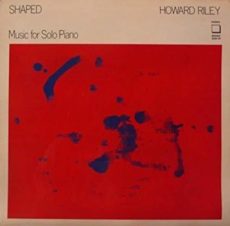
Daily Dose Of Jazz…
Howard Riley was born on John Howard Riley on February 16, 1943 in Huddersfield, Yorkshire, England. He began learning the piano at the age of six and started playing jazz as early as the age of 13. He studied at the University of Wales from 1961 to 1966, then Indiana University, and finishing up at York University in 1970). While studying he played jazz professionally, with Evan Parker (1966) and then with his own trio (1967–76), with Barry Guy on bass and Alan Jackson, Jon Hiseman, and Tony Oxley for periods on drums.
He worked with John McLaughlin in the late Sixties, the London Jazz Composers Orchestra and Oxley’s ensemble through the Seventies to 1981. He and Guy worked in a trio with Phil Wachsmann from 1976 well into the 1980s and played solo piano throughout North America and Europe. He played in a quartet, with Guy, Trevor Watts, and John Stevens, did duo work with Keith Tippett, with Jaki Byard, and with Elton Dean. From 1985 he worked in a trio with Jeff Clyne and Tony Levin.
Pianist and composer Howard Riley who worked in jazz and experimental music idioms continues to teach at the Guildhall School of Music and Drama and Goldsmiths, University of London, where he has taught since the 1970s.
More Posts: bandleader,educator,history,instrumental,jazz,music,piano



